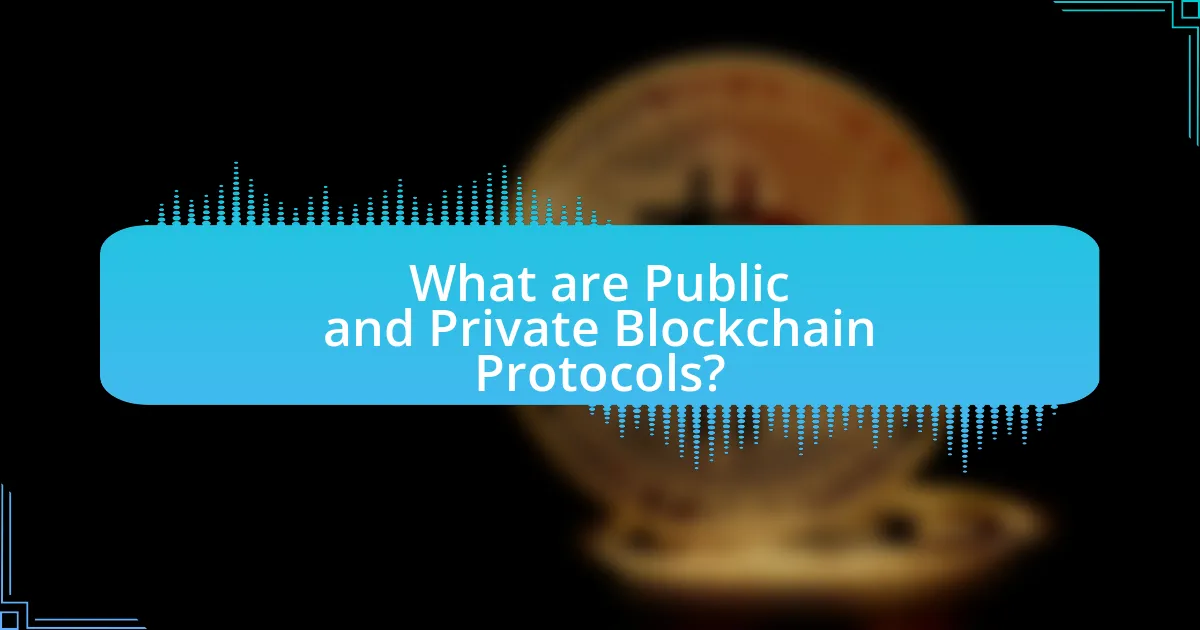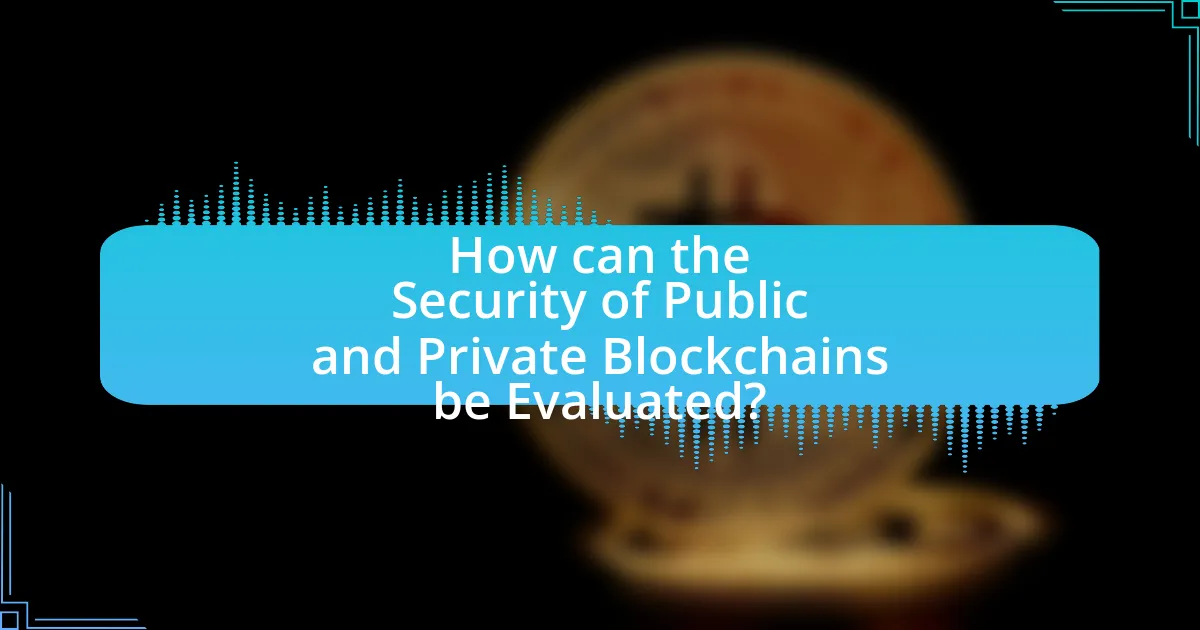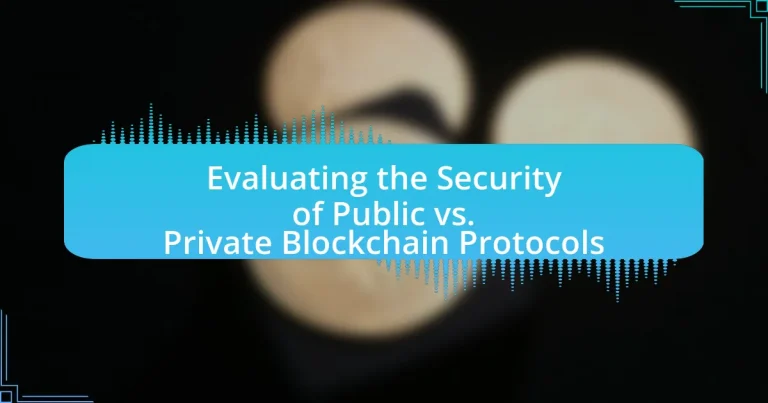The article evaluates the security of public and private blockchain protocols, highlighting their distinct characteristics and inherent risks. Public blockchains, such as Bitcoin and Ethereum, are decentralized and prioritize transparency, while private blockchains, like Hyperledger and R3 Corda, offer restricted access and enhanced privacy for specific organizations. Key security measures, including consensus mechanisms and cryptographic techniques, are examined for both types of blockchains, alongside their vulnerabilities and potential threats. The discussion also covers best practices for securing blockchain protocols and the future trends in blockchain security evaluation, emphasizing the role of emerging technologies and regulatory frameworks in enhancing security measures.

What are Public and Private Blockchain Protocols?
Public blockchain protocols are decentralized networks that allow anyone to participate in the network, validate transactions, and access the blockchain’s data, exemplified by Bitcoin and Ethereum. In contrast, private blockchain protocols are restricted networks where access is limited to specific participants, often used by organizations for internal purposes, such as Hyperledger and R3 Corda. The distinction lies in their accessibility and governance; public blockchains prioritize transparency and inclusivity, while private blockchains focus on control and privacy for specific use cases.
How do Public Blockchain Protocols function?
Public blockchain protocols function through a decentralized network of nodes that validate and record transactions on a shared ledger. Each node maintains a copy of the entire blockchain, ensuring transparency and security. When a transaction is initiated, it is broadcast to the network, where nodes compete to validate it through a consensus mechanism, such as Proof of Work or Proof of Stake. Once validated, the transaction is added to a block, which is then appended to the existing blockchain. This process is secured by cryptographic techniques, making it nearly impossible to alter past transactions without the consensus of the majority of the network. The decentralized nature of public blockchains enhances security by eliminating single points of failure and reducing the risk of fraud.
What are the key characteristics of Public Blockchain Protocols?
Public blockchain protocols are characterized by decentralization, transparency, immutability, and security. Decentralization ensures that no single entity controls the network, allowing for distributed consensus among participants. Transparency allows all transactions to be visible to anyone, fostering trust and accountability. Immutability means that once data is recorded on the blockchain, it cannot be altered or deleted, which enhances data integrity. Security is achieved through cryptographic techniques and consensus mechanisms, such as Proof of Work or Proof of Stake, which protect the network from malicious attacks. These characteristics collectively contribute to the robustness and reliability of public blockchain protocols.
What security measures are inherent in Public Blockchain Protocols?
Public blockchain protocols inherently incorporate several security measures, including decentralization, cryptographic hashing, consensus mechanisms, and transparency. Decentralization ensures that no single entity controls the network, reducing the risk of manipulation or failure. Cryptographic hashing secures data integrity by converting transaction information into a fixed-size string, making it nearly impossible to alter without detection. Consensus mechanisms, such as Proof of Work or Proof of Stake, validate transactions and maintain network integrity by requiring participants to agree on the state of the blockchain. Transparency allows all participants to view transaction history, fostering trust and accountability. These measures collectively enhance the security of public blockchain protocols, making them resilient against attacks and fraud.
How do Private Blockchain Protocols function?
Private blockchain protocols function by allowing a limited number of participants to access and validate transactions on the network, ensuring that only authorized entities can participate in the consensus process. These protocols utilize permissioned access, meaning that participants must be granted specific rights to join the network, which enhances security by controlling who can view and interact with the blockchain.
In contrast to public blockchains, where anyone can join and validate transactions, private blockchains restrict access to a select group, often within an organization or consortium. This structure allows for faster transaction processing and greater privacy, as sensitive data can be kept confidential among trusted parties.
The consensus mechanisms in private blockchains, such as Practical Byzantine Fault Tolerance (PBFT) or delegated proof of stake, are designed to facilitate agreement among the known participants, further enhancing security by reducing the risk of malicious attacks that are more prevalent in public networks.
What are the key characteristics of Private Blockchain Protocols?
Private blockchain protocols are characterized by restricted access, centralized control, and enhanced privacy. Unlike public blockchains, which allow anyone to participate, private blockchains require permission for access, ensuring that only authorized users can join the network. This centralized control allows for faster transaction processing and consensus mechanisms, as fewer nodes are involved in decision-making. Additionally, private blockchains prioritize data confidentiality, often employing encryption and access controls to protect sensitive information. These characteristics make private blockchains suitable for enterprises and organizations that require secure and efficient data management while maintaining control over their networks.
What security measures are inherent in Private Blockchain Protocols?
Private blockchain protocols incorporate several inherent security measures, including access control, data encryption, and consensus mechanisms. Access control restricts participation to authorized users, ensuring that only vetted entities can validate transactions and access the blockchain. Data encryption protects sensitive information from unauthorized access, maintaining confidentiality and integrity. Consensus mechanisms, such as Practical Byzantine Fault Tolerance (PBFT) or Proof of Authority (PoA), enhance security by requiring a majority agreement among trusted nodes before validating transactions, thus preventing malicious activities. These measures collectively create a secure environment that mitigates risks associated with unauthorized access and data tampering.

What are the Security Implications of Public vs. Private Blockchains?
Public blockchains are generally more secure against censorship and tampering due to their decentralized nature, while private blockchains offer enhanced control and privacy but may be more vulnerable to insider threats. Public blockchains, like Bitcoin, utilize a consensus mechanism that requires validation from multiple independent nodes, making it difficult for any single entity to manipulate the data. In contrast, private blockchains, such as Hyperledger, often rely on a limited number of trusted nodes, which can lead to potential security risks if those nodes are compromised. Additionally, the transparency of public blockchains allows for greater scrutiny and auditing, which can enhance security, whereas private blockchains may lack this level of oversight, increasing the risk of fraud or data breaches.
What are the main security risks associated with Public Blockchains?
The main security risks associated with public blockchains include 51% attacks, smart contract vulnerabilities, and privacy concerns. A 51% attack occurs when a single entity gains control of more than half of the network’s mining power, allowing them to manipulate transactions and double-spend coins. This risk is particularly relevant in smaller networks where fewer miners are involved. Smart contract vulnerabilities arise from coding errors or exploits within the contracts themselves, leading to potential financial losses; for instance, the DAO hack in 2016 resulted in the loss of $60 million worth of Ether due to a vulnerability in the smart contract code. Privacy concerns stem from the transparent nature of public blockchains, where transaction details are visible to all participants, potentially exposing sensitive information. These risks highlight the inherent vulnerabilities in public blockchain systems compared to private blockchain protocols, which often implement stricter access controls and governance mechanisms.
How do consensus mechanisms impact security in Public Blockchains?
Consensus mechanisms significantly impact security in public blockchains by ensuring that all participants agree on the validity of transactions, thus preventing double-spending and fraud. For instance, Proof of Work, used by Bitcoin, requires miners to solve complex mathematical problems, which secures the network against attacks by making it computationally expensive to alter transaction history. In contrast, Proof of Stake, utilized by Ethereum 2.0, enhances security by requiring validators to lock up their cryptocurrency as collateral, incentivizing honest behavior and reducing the likelihood of malicious actions. These mechanisms collectively contribute to the integrity and reliability of public blockchains, as evidenced by Bitcoin’s resilience against attacks since its inception in 2009, where no successful double-spending has occurred despite its widespread use.
What vulnerabilities are commonly found in Public Blockchains?
Public blockchains commonly exhibit vulnerabilities such as 51% attacks, smart contract flaws, and Sybil attacks. A 51% attack occurs when a single entity controls the majority of the network’s mining power, allowing them to manipulate transactions and double-spend coins. Smart contract flaws arise from coding errors or vulnerabilities in the contract logic, which can be exploited to drain funds or disrupt operations; for instance, the DAO hack in 2016 exploited a vulnerability in a smart contract, resulting in a loss of $60 million. Sybil attacks involve an adversary creating multiple identities to gain influence over the network, undermining its integrity and consensus mechanisms. These vulnerabilities highlight the inherent risks associated with public blockchain systems.
What are the main security risks associated with Private Blockchains?
The main security risks associated with private blockchains include centralized control, limited transparency, and susceptibility to insider threats. Centralized control arises because private blockchains are typically governed by a single organization or consortium, which can lead to a single point of failure and potential manipulation of data. Limited transparency restricts the ability of external parties to audit transactions, increasing the risk of fraud or mismanagement. Additionally, insider threats are heightened in private blockchains, as authorized users may exploit their access to compromise the system. These risks highlight the need for robust governance and security measures in private blockchain implementations.
How does access control affect security in Private Blockchains?
Access control significantly enhances security in private blockchains by regulating who can participate in the network and what actions they can perform. This selective access ensures that only authorized users can view, modify, or validate transactions, thereby reducing the risk of unauthorized access and potential malicious activities. For instance, private blockchains often implement role-based access control (RBAC) or attribute-based access control (ABAC), which allows for fine-grained permissions tailored to specific user roles. This structured approach minimizes vulnerabilities, as it limits exposure to sensitive data and transaction capabilities to trusted entities only. Consequently, the implementation of robust access control mechanisms is crucial for maintaining the integrity and confidentiality of the data within private blockchains.
What vulnerabilities are commonly found in Private Blockchains?
Common vulnerabilities found in private blockchains include centralization risks, access control weaknesses, and lack of transparency. Centralization risks arise because private blockchains often have a limited number of nodes, which can lead to a single point of failure and increased susceptibility to collusion among participants. Access control weaknesses can occur if permissions are not properly managed, allowing unauthorized users to manipulate data or transactions. Additionally, the lack of transparency in private blockchains can hinder auditing processes and reduce trust among stakeholders, as the data is not publicly verifiable. These vulnerabilities highlight the need for robust security measures in private blockchain implementations.

How can the Security of Public and Private Blockchains be Evaluated?
The security of public and private blockchains can be evaluated through a combination of consensus mechanisms, network architecture, and vulnerability assessments. Public blockchains, like Bitcoin, utilize decentralized consensus protocols such as Proof of Work, which enhances security by requiring significant computational resources to alter the blockchain. In contrast, private blockchains often rely on permissioned access and centralized control, which can lead to vulnerabilities if the governing entity is compromised.
Evaluating security also involves analyzing the cryptographic algorithms used for data integrity and confidentiality. For instance, public blockchains typically employ robust cryptographic techniques like SHA-256, while private blockchains may use less rigorous methods depending on their specific use cases.
Furthermore, conducting penetration testing and threat modeling can reveal potential weaknesses in both types of blockchains. Historical incidents, such as the DAO hack in Ethereum, illustrate how vulnerabilities can be exploited, emphasizing the need for continuous security assessments. Thus, a comprehensive evaluation of blockchain security must consider these factors to determine the resilience of both public and private systems against attacks.
What metrics are used to assess the security of Blockchain protocols?
Metrics used to assess the security of Blockchain protocols include consensus mechanism robustness, transaction finality, network decentralization, cryptographic strength, and resistance to attacks. Consensus mechanism robustness evaluates how well the protocol can achieve agreement among nodes, with proof-of-work and proof-of-stake being common examples. Transaction finality measures the certainty that a transaction cannot be reversed, which is crucial for security. Network decentralization assesses the distribution of control among participants; a highly decentralized network is generally more secure against attacks. Cryptographic strength involves the algorithms used to secure data, with stronger algorithms providing better protection. Lastly, resistance to attacks, such as Sybil attacks or 51% attacks, indicates how well the protocol can withstand malicious attempts to compromise its integrity. These metrics collectively provide a comprehensive view of a blockchain protocol’s security posture.
How do transaction throughput and latency affect security evaluations?
Transaction throughput and latency significantly impact security evaluations by influencing the ability to process and confirm transactions efficiently. High transaction throughput allows a blockchain to handle a larger volume of transactions, which can enhance security by reducing the likelihood of network congestion and potential attacks, such as double-spending. Conversely, low latency ensures that transactions are confirmed quickly, minimizing the window of opportunity for malicious actors to exploit delays in transaction finality. For instance, in public blockchains like Bitcoin, a higher throughput can lead to faster confirmations, thereby strengthening security against certain types of attacks, as evidenced by the network’s resilience during peak usage periods. Thus, both throughput and latency are critical metrics in assessing the overall security posture of blockchain protocols.
What role does network decentralization play in security assessments?
Network decentralization significantly enhances security assessments by distributing control and reducing single points of failure. In decentralized networks, such as public blockchains, the consensus mechanism relies on multiple independent nodes, making it more difficult for malicious actors to manipulate data or execute attacks. For instance, the Bitcoin network, which operates on a decentralized model, has demonstrated resilience against attacks due to its vast number of nodes and the requirement for consensus among them. This structure not only increases transparency but also fosters trust, as no single entity can unilaterally alter the blockchain. Consequently, the decentralized nature of these networks plays a crucial role in fortifying security assessments by ensuring that vulnerabilities are minimized and the integrity of the system is maintained.
What best practices can enhance the security of Blockchain protocols?
Implementing multi-signature authentication significantly enhances the security of blockchain protocols by requiring multiple private keys to authorize transactions. This reduces the risk of unauthorized access, as a single compromised key is insufficient for transaction approval. Additionally, regular security audits and code reviews help identify vulnerabilities in the blockchain’s smart contracts and underlying code, ensuring that potential exploits are addressed promptly. Furthermore, employing robust cryptographic algorithms, such as SHA-256, ensures data integrity and confidentiality, making it difficult for attackers to manipulate the blockchain. Finally, educating users about phishing attacks and secure key management practices is crucial, as human error often leads to security breaches. These best practices collectively fortify blockchain protocols against various security threats.
How can organizations implement effective security measures for Public Blockchains?
Organizations can implement effective security measures for public blockchains by utilizing a combination of cryptographic techniques, consensus mechanisms, and regular security audits. Cryptographic techniques, such as hashing and digital signatures, ensure data integrity and authenticity, making it difficult for malicious actors to alter transaction records. Consensus mechanisms, like Proof of Work or Proof of Stake, help secure the network by requiring participants to validate transactions, thus preventing double-spending and ensuring that only legitimate transactions are added to the blockchain. Regular security audits, including vulnerability assessments and penetration testing, help identify and mitigate potential security risks, ensuring that the blockchain remains resilient against attacks. These measures collectively enhance the security posture of public blockchains, as evidenced by the robust security frameworks employed by leading blockchain networks like Bitcoin and Ethereum, which have successfully operated for years without major breaches.
What strategies can organizations use to secure Private Blockchains?
Organizations can secure Private Blockchains by implementing access control mechanisms, encryption, and regular audits. Access control mechanisms, such as role-based access control (RBAC), ensure that only authorized users can interact with the blockchain, thereby reducing the risk of unauthorized access. Encryption protects data both at rest and in transit, making it difficult for unauthorized parties to decipher sensitive information. Regular audits help identify vulnerabilities and ensure compliance with security policies, thereby maintaining the integrity of the blockchain. These strategies collectively enhance the security posture of Private Blockchains, ensuring that sensitive data remains protected from potential threats.
What are the future trends in Blockchain security evaluation?
Future trends in blockchain security evaluation include the increased adoption of automated security assessment tools, enhanced focus on smart contract auditing, and the integration of artificial intelligence for threat detection. Automated tools streamline the evaluation process, reducing human error and increasing efficiency, as evidenced by the growing use of platforms like MythX and Slither for smart contract analysis. Additionally, the rise in decentralized finance (DeFi) has heightened the need for rigorous smart contract audits, with firms like CertiK reporting a surge in demand for their auditing services. Furthermore, AI technologies are being leveraged to predict and identify vulnerabilities in blockchain networks, with research indicating that machine learning models can significantly improve the accuracy of threat detection. These trends reflect a proactive approach to addressing the evolving security challenges in both public and private blockchain protocols.
How might emerging technologies influence Blockchain security?
Emerging technologies such as artificial intelligence (AI), quantum computing, and advanced cryptography significantly influence blockchain security by enhancing threat detection, improving encryption methods, and addressing vulnerabilities. AI can analyze vast amounts of data to identify anomalies and potential security breaches in real-time, thereby strengthening the overall security posture of blockchain networks. Quantum computing poses a challenge to traditional cryptographic algorithms used in blockchain, necessitating the development of quantum-resistant algorithms to safeguard against potential attacks. Furthermore, advancements in cryptography, such as zero-knowledge proofs, enhance privacy and security by allowing transactions to be verified without revealing sensitive information. These technologies collectively contribute to a more robust and secure blockchain environment, addressing both current and future security challenges.
What role will regulatory frameworks play in Blockchain security evaluations?
Regulatory frameworks will play a crucial role in Blockchain security evaluations by establishing standards and guidelines that enhance security measures. These frameworks will help ensure compliance with legal requirements, thereby fostering trust among users and stakeholders. For instance, regulations like the General Data Protection Regulation (GDPR) in Europe mandate data protection measures that directly impact how blockchain systems handle personal data, influencing their security protocols. Additionally, regulatory bodies may require regular audits and assessments, which can lead to improved security practices and the identification of vulnerabilities. This structured approach to security evaluation will ultimately contribute to the overall integrity and reliability of blockchain technologies.

















